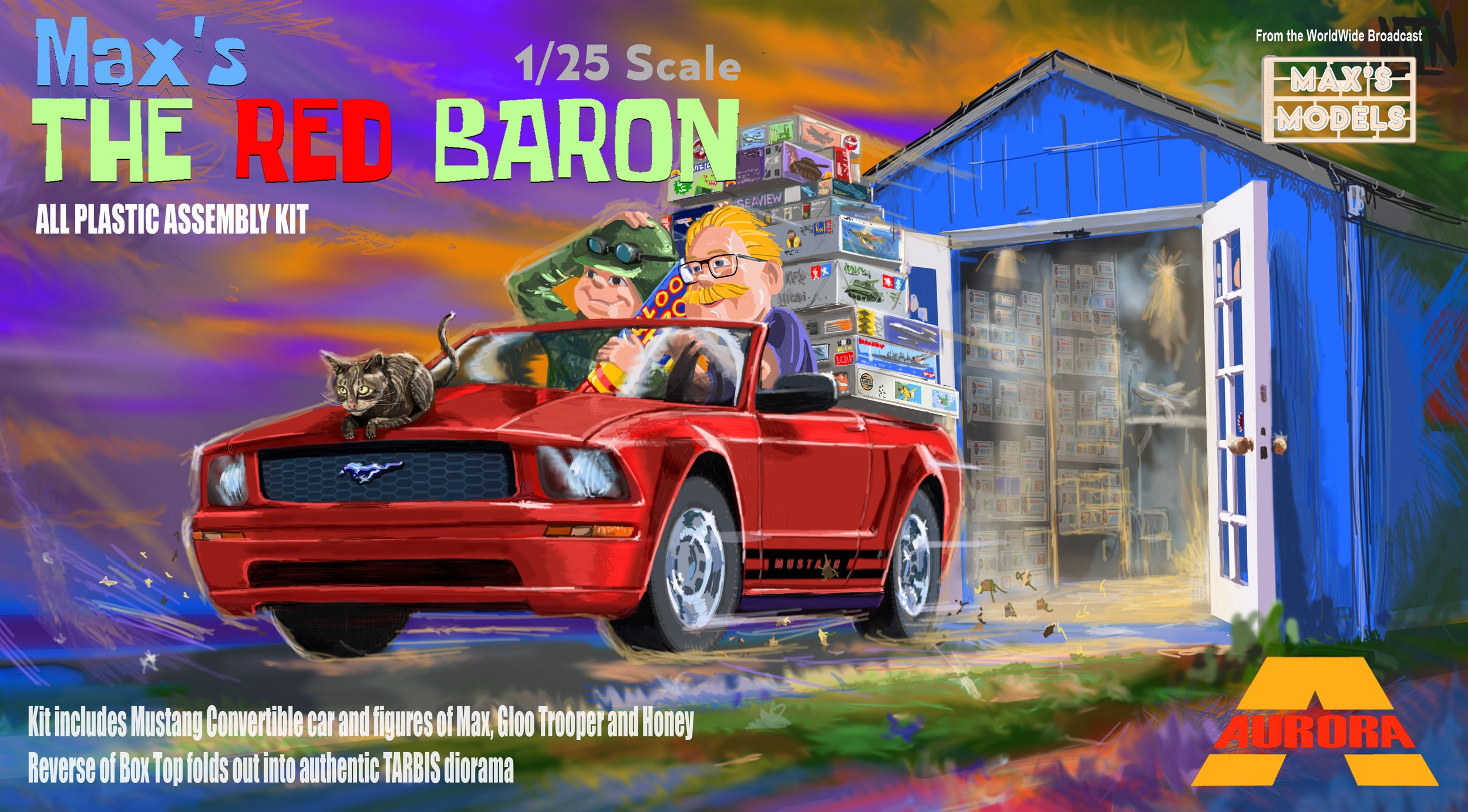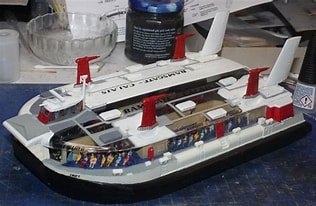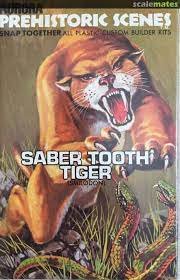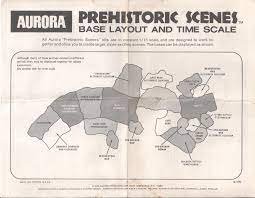PLASTIC MODEL KITS
July 2023
I have had a lot of fun recently making videos of my ‘What If..’ model kit box art. The response has been great. The subjects really seem to resonate with people and everyone has a particular favourite. Comments often include things like ‘I used to love that show’, or I ‘I haven’t seen that movie in years’ or ‘I would have bought a kit of that instantly!’.
My favourite comment was from someone who liked the box art for the magnificent Fireflash Airliner from the TV series ‘Thunderbirds’. This person had not seen the show and my artwork and the video inspired them to watch the first episode. And they loved it! And are now watching more!
I have been working on these various paintings off and on over the past few years, but I was recently inspired to put a video together based on a video by Mike Machat – on his excellent Celebrating Aviation with Mike Machat YouTube channel. This video (linked below) talks about some real aircraft on his wish-list for kits nobody ever made. With incredible box art.
https://www.youtube.com/@c Channelselebratingaviationwithmik9782
I must also thank Max at Max’s Models YouTube channel who regularly posts videos celebrating all things Plastic Model Kits. He doesn’t just purchase, collect, do a ‘box review’ and then put them on the shelf, he actually builds them too. Very inspiring and always great fun.
Here is a link to Mas’s Model
https://www.youtube.com/@maxsmodels
I recently did a commissioned piece for ‘Max’s Models’. Creating artwork for yourself is one thing, but there is no substitute for working on something for someone else. There is a level of research on the subject matter that is required and can really inspire as well as inform the piece. And knowing the sensibilities of the person commissioning the piece is a key part of the overall success too. Thank You Max for the opportunity.
In addition to creating the artwork, I like trying to imagine some specifics of what the actual kit might be like. In the 1970s when I was growing up and making models, making model kits was popular and Airfix, Matchbox, Monogram and many other manufacturers seemed to be bringing out new kits every couple of weeks. We’d visit our local Hobby Shop – the great BEATTIES of LONDON – and there as always something NEW on the shelves.
Back in those days kits would come in all sorts of different colours of plastic. The plastic was usually a colour that was close to the main colour of one of the paint schemes. Tanks would usually come in a suitable military green, or sometimes a sandy yellow if they were desert based. WW2 RAF bombers would be in black plastic. Airliners and civilian aircraft would be typically in white plastic. WW2 German fighters and bombers would come in a sort of sky-blue colour (presumably favouring the underside colour scheme). US aircraft were often moulded in a silvery grey plastic to resemble the polished or bare metal surfaces. This particular styrene had the unique trait of showing swirls of the silver pigmentation. There were efforts made to accommodate even the most flamboyant colour schemes. The Fokker Triplane made famous by Baron von Richthofen - ‘The Red Baron’ of the Great War - was moulded in bright red plastic. Stevenson’s Rocket – the original steam locomotive – was moulded in bright yellow. Light grey plastic, which is the norm for almost every kit these days, was used back then but was reserved for WW1 and WW2 battleships.
The box top often would say something like ‘No painting required’. Or ‘moulded in color’ if it was a US manufacturer.
The most outstanding kit I remember for its colour of plastic was an Airfix 747 Jumbo Jet of Braniff Airways, whose livery was a bright orange fuselage and the kit was bright orange. It was almost 2 feet long and the impact of opening the box and seeing all this orange plastic was quite a sight!
A remember a dinosaur kit (not Aurora) that came in a shocking purple plastic. And one of the famous Aurora Dinosaurs / Prehistoric Scenes was a sort of metallic bronze! The dimetrodon. And the Allosaurus was a vivid metallic green!
Matchbox made kits in 2 or sometimes 3 colours if it was a larger kit. This idea was a neat gimmick, and probably worked out better on paper. The parts breakdown was spread across the 2 or 3 sprues quite thoughtfully. For example - a Lancaster bomber would probably have a sprue of black plastic which would include the wheels, propellers, guns and other detail pieces. Then there might be a green sprue for the fuselage halves and upper wing and tail plane surfaces, and a brown sprue for the lower wing and tail planes. Some kits were more successful than others and sometimes it seemed like the multiple colours was not as effective as if it had been in one colour only.
Among their range was a line of 1/76th scale armoured fighting vehicles, tanks, halftracks, armoured cars and the like. The parts breakdown usually worked very well with wheels and armament often in a different shade of the colour used for the hull and the turret. A sandy yellow for the tank’s hull and light brown for the wheels. The flexible tracks were easy to connect and attack and were typically I black vinyl. Even unpainted the kits looks great.
These all came with small diorama bases suitable to the vehicle and a typical battleground. The Russian T34 has a snow-covered field. Smaller vehicles were enhanced with a larger and more complex diorama base. They often included dynamically posed figures who looked ready to fight. These kits were fantastic. I put the ‘Blakes 7’ Liberator as a Matchbox kit, because Matchbox released the ‘Star Trek The Motion Picture’ kits and I thought it would be funny to imagine the Liberator – which is basically all white, but produced in three colours of plastic. That said, white, light grey and maybe gold, or red could be made to look quite decent. But all white plastic would probably look better.
I try to imagine the time when the kits would be made… before the movies became cult or bona fide classics. Movie tie -ins are planned long before the film’s release and everyone has high hopes for the success. So text like ‘from the exciting new film’ for a film that turned out to be a bit of a dud is sort of funny and true to life 😊
I like to think about what the kit may feature in terms of details, features, optional parts and figures.
Aurora’s Sci-Fi kits – the Flying Sub from ‘Voyage to the Bottom of the Sea’, the Flying Saucer from ‘The Invaders’ The Spindrift from ‘Land of the Giants’ the Moon bus from ‘2001 A Space Odyssey’ all had removable sections of the upper hull which revealed detailed interiors, with figures. The Orion Pan-Am space clipper from 2001 had a removable tail section that revealed a power plant. Cool.
The aforementioned ‘Prehistoric Scenes’ kits were ‘Snap-Fix’ and had joints so that they could be made to stand in several positions. They had elaborate diorama bases that featured suitably raw and rugged landscapes. Each kit came in its own unique colour. A bonus was that the bases could be fitted together into a continuous landscape with a Triceratops, a Tyrannosaurus Rex and even a caveman all next to each other. This would be quite massive and very expensive…and anachronistic as the animals and figures in the range were from many different time periods each million of years apart. But that didn’t really matter. I don’t know how accurate they were – I recall the Triceratops looked like the one in the Raquel Welch / Ray Harryhausen movie ‘One Million Years B.C.’ which was enough credibility for me.
Aurora’s other big line was their ‘Monsters of the Movies’ kits. Specifically, from the Universal Horror movies of the 1930s, 40s, and 50s. Dracula, the Wolf Man, the Mummy and Frankenstein (perpetrating the confusion between the doctor named Frankenstein and The Creature, or Frankenstein’s Monster (immortalised by Boris Karloff’s performance and Jack Peirce’s make-up). These very popular kits had a special release that featured ‘Glow in the Dark’ parts – heads, hands and accessories were provided as additional parts on small luminous sprue. I recall my Godzilla kit sitting at the foot of my bed, with his head and neck and claws glowing an eerie green when the lights were out. Only for a few minutes, but creepy stuff for a 10-year-old.
Older kits would sometime have quite ingenious or unique had features. or gimmicks. Retractable undercarriage, moving flaps and rudders, poseable guns and gun turrets were all standard on large kits…sometimes at the expense of accuracy. Sometimes landing gear would be simplified I order to be workable on the kit.
Airfix did a kit of the giant SRN4 hovercraft where half of the upper hull was moulded in clear plastic revealing the fully detailed interior. This Included a handful of cars on the car deck. Revell did a ‘cutaway’ Boeing 747 Jumbo Jet with a clear side. Revell also did a nuclear submarine that had an open side, and you could see the missile room, engine room, bridge and crew’s quarters. I seem to recall a lot of decals added to the moulded details.
I think one of the most outlandish gimmick I recall was the ‘photo-scope’. This was something Aurora added to a few kits – submarines and tanks. I believe. There was a hole in the kit that allowed light to pass through it. There was a photographic slide, or transparency of showing a portion of the interior of the real thing. When you held it up to the light the transparency would be illuminated and it was like you were looking down into a real sub, tank or what have you. Very low tech, but ingenious and reminiscent of ’View-Master’ technology.
Model Kits are much more accurate and detailed today…and much more expensive. There are many of these sci-fi and movie vehicles and ships being made now as either limited run ‘garage kits’ in solid resin or 3d printed, but also, mainstream injection moulded kits of things from 50 or 60 year old classic movies such as ‘The War of the Worlds’, ‘When Worlds Collide’ and ‘2001: A Space Odyssey .
But the ‘What If…’ box top artwork series is primarily a way to visualise the kits I wish they had made when I was a kid growing up. I recall seeing ‘Battlestar Galactica’ and ‘Star Trek The Motion Picture’ and being able to go an buy and the kits straight away. This was a great thrill – extending the experience via these model kits.
It is great fun to imagine and share what might have been. Or, maybe, what might be one day in the future.
The WHAT IF… Gallery features dozens of imagined kits.
This graphic, and more are available from REDBUBBLE on a T-Shirts, Mugs, Phone Cases, Stickers etc. Redbubble




































